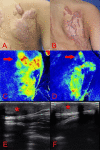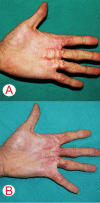Treatment of hypertrophic scars and keloids using an intralesional 1470 nm bare-fibre diode laser: a novel efficient minimally-invasive technique
- PMID: 33303965
- PMCID: PMC7728807
- DOI: 10.1038/s41598-020-78738-9
Treatment of hypertrophic scars and keloids using an intralesional 1470 nm bare-fibre diode laser: a novel efficient minimally-invasive technique
Abstract
Hypertrophic and keloid scars result from abnormal wound healing and can have a variable response to a number of available treatment modalities. The evolution of laser treatments in recent years has shown a wide range of clinical applications including their use in the treatment of scars. We investigated the effectiveness of a 1470 nm diode laser using an intralesional optical fibre delivery device in the treatment of hypertrophic and keloid scars. We evaluated its safety and efficacy as a novel and minimally invasive treatment alternative for scar modulation and volume reduction. A prospective cohort study was performed involving 21 patients with hypertrophic scars (HS) (n = 9) and keloids (n = 12) resulting from various aetiology. Patients were treated with one to three treatment sessions. Comprehensive evaluations were performed using the Vancouver Scar Scale, Doppler ultrasound, Cutometer, Mexameter and PeriCam PSI. Scar thickness was reduced by an average of 0.308 ± 0.138 cm (p < 0.001). In particular the two subgroups showed a significant 27.7% and 28.2% reduction in scar thickness of HS and Keloids, respectively. Scar firmness showed a significant improvement of 1.2% (p < 0.05) for HS, though for keloids this was 0.4% (p = 0.26). Keloids had a significant reduction in pigmentation at 21.3%. Blood perfusion had a significant reduction of 29.6% in HS and 22.7% in Keloids. Overall VSS total score improvement of 42% in the HS and at 37.9% in the Keloid subgroup. No adverse events such as hypo/hyperpigmentation, skin infection, or recurrence were reported. This study shows that the intralesional 1470 nm bare-fibre diode laser significantly improved hypertrophic and keloid scars based on both subjective and objective analyses and supports this type of laser therapy as a safe and effective minimally-invasive treatment option.
Conflict of interest statement
The authors declare no competing interests.
Figures






Similar articles
-
Intralesional cryotherapy for enhancing the involution of hypertrophic scars and keloids.Plast Reconstr Surg. 2003 May;111(6):1841-52. doi: 10.1097/01.PRS.0000056868.42679.05. Plast Reconstr Surg. 2003. PMID: 12711943
-
Laser treatment of hypertrophic scars, keloids, and striae.Dermatol Clin. 1997 Jul;15(3):419-29. doi: 10.1016/s0733-8635(05)70451-4. Dermatol Clin. 1997. PMID: 9189679 Review.
-
[Clinical effect of Zhang's super tension-relieving suture for high-tension wound closure].Zhonghua Shao Shang Za Zhi. 2020 May 20;36(5):339-345. doi: 10.3760/cma.j.cn501120-20200314-00163. Zhonghua Shao Shang Za Zhi. 2020. PMID: 32456370 Chinese.
-
Keloid and Hypertrophic Scars Treatment.Aesthetic Plast Surg. 2024 Jul;48(13):2553-2560. doi: 10.1007/s00266-024-03869-7. Epub 2024 Mar 7. Aesthetic Plast Surg. 2024. PMID: 38453710
-
Treatment of scars: a review.Ann Plast Surg. 1997 Oct;39(4):418-32. doi: 10.1097/00000637-199710000-00014. Ann Plast Surg. 1997. PMID: 9339286 Review.
Cited by
-
Impact of Vitamin D Injection on Keloids and Hypertrophic Scars.J Cosmet Dermatol. 2025 Apr;24(4):e70118. doi: 10.1111/jocd.70118. J Cosmet Dermatol. 2025. PMID: 40135774 Free PMC article. Clinical Trial.
-
Asiaticoside-laden silk nanofiber hydrogels to regulate inflammation and angiogenesis for scarless skin regeneration.Biomater Sci. 2021 Jul 27;9(15):5227-5236. doi: 10.1039/d1bm00904d. Biomater Sci. 2021. PMID: 34190240 Free PMC article.
-
The Endo-lift Laser (Intralesional 1470 nm Diode Laser) for Dermatological Aesthetic Conditions: A Systematic Review.Aesthetic Plast Surg. 2024 Dec;48(23):5097-5114. doi: 10.1007/s00266-024-04082-2. Epub 2024 Jun 17. Aesthetic Plast Surg. 2024. PMID: 38886198
-
Hypertrophic Scars and Keloids: Advances in Treatment and Review of Established Therapies.Am J Clin Dermatol. 2023 Mar;24(2):225-245. doi: 10.1007/s40257-022-00744-6. Epub 2023 Jan 20. Am J Clin Dermatol. 2023. PMID: 36662366 Review.
-
Controlling Inflammation Pre-Emptively or at the Time of Cutaneous Injury Optimises Outcome of Skin Scarring.Front Immunol. 2022 May 27;13:883239. doi: 10.3389/fimmu.2022.883239. eCollection 2022. Front Immunol. 2022. PMID: 35711461 Free PMC article. Review.
References
-
- Meymandi SS, Moosazadeh M, Rezazadeh A. Comparing Two methods of cryotherapy and intense pulsed light with triamcinolone injection in the treatment of keloid and hypertrophic scars: a clinical trial. Osong Public Health Res. Perspect. 2016;7:313–319. doi: 10.1016/j.phrp.2016.08.005. - DOI - PMC - PubMed
Publication types
MeSH terms
LinkOut - more resources
Full Text Sources

